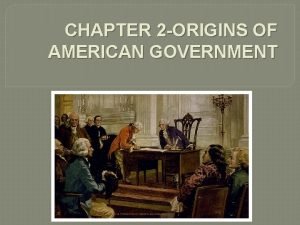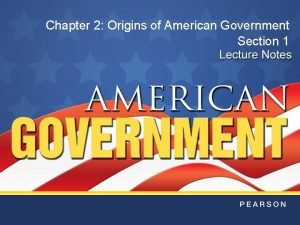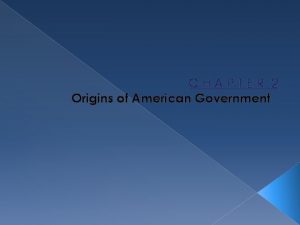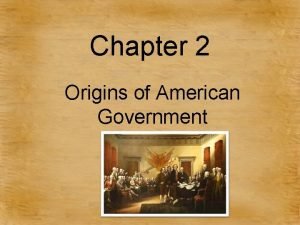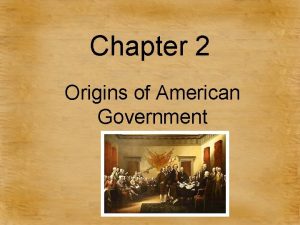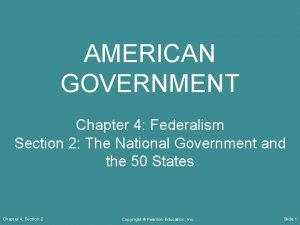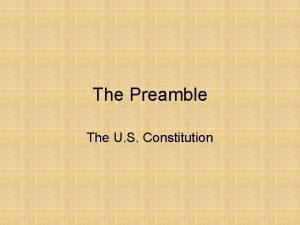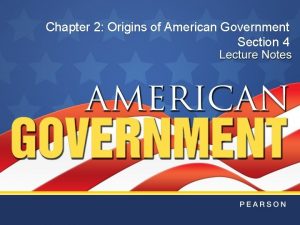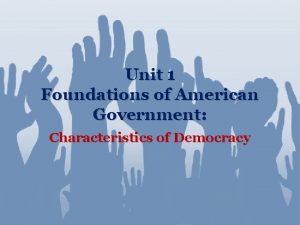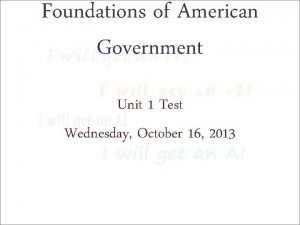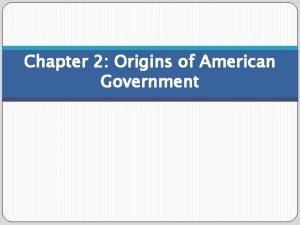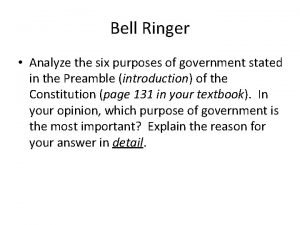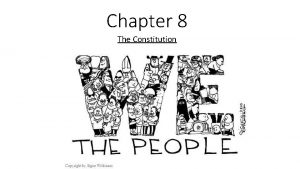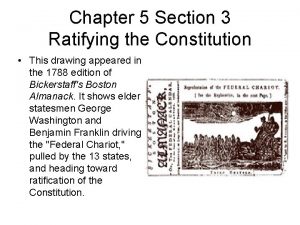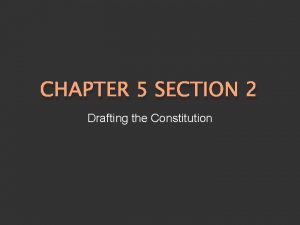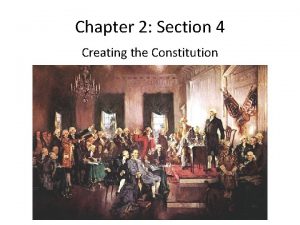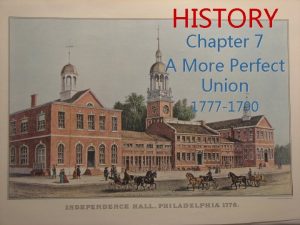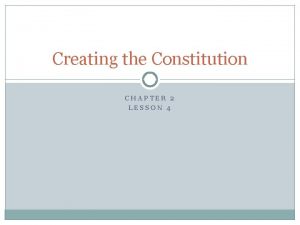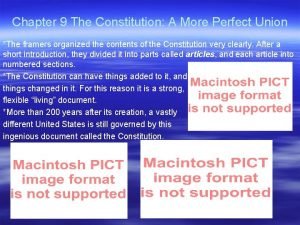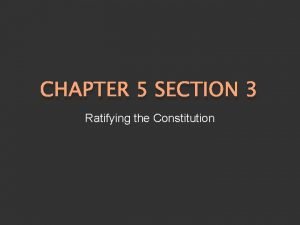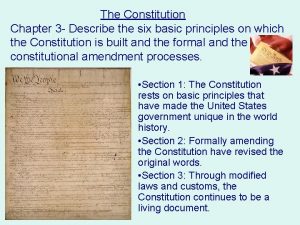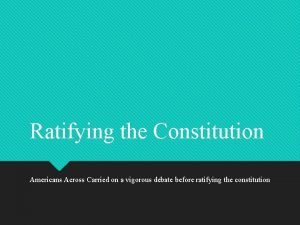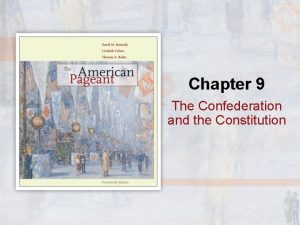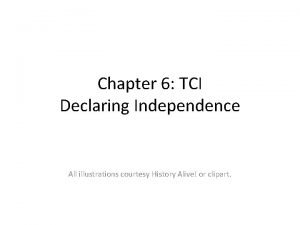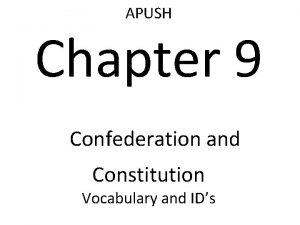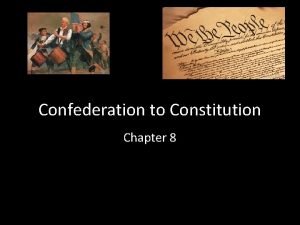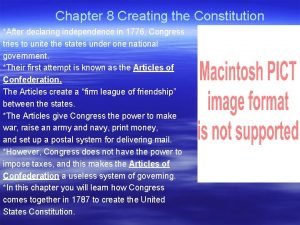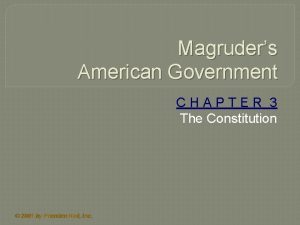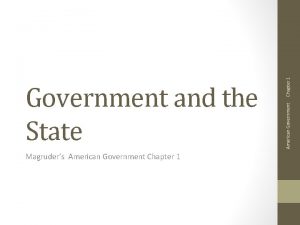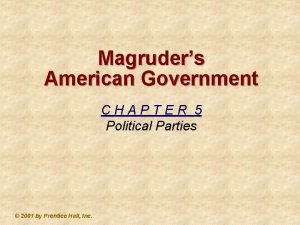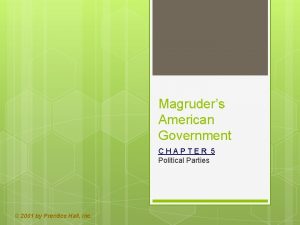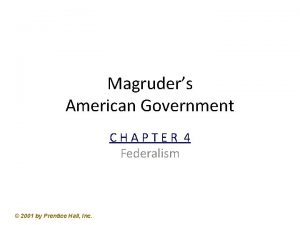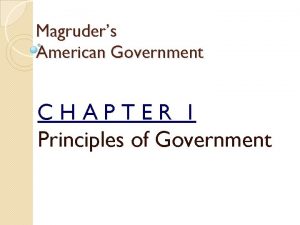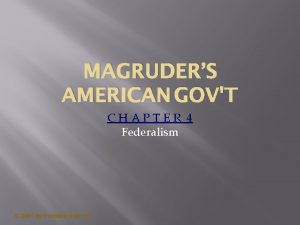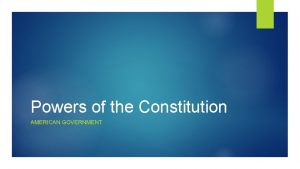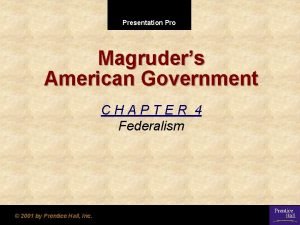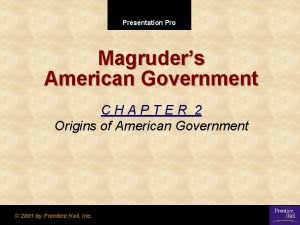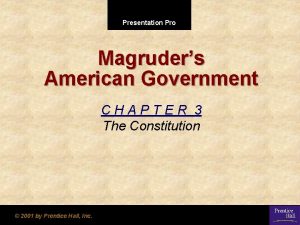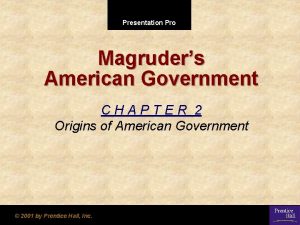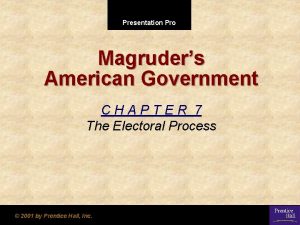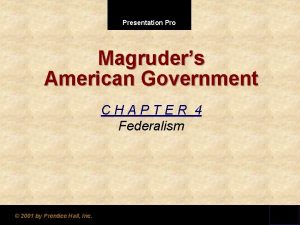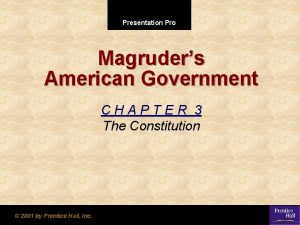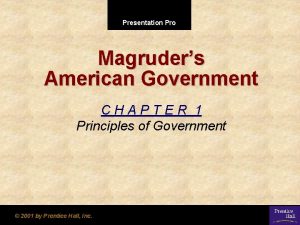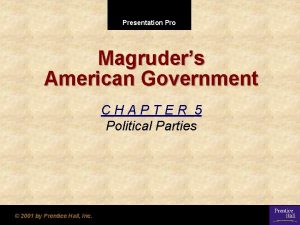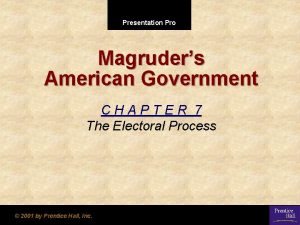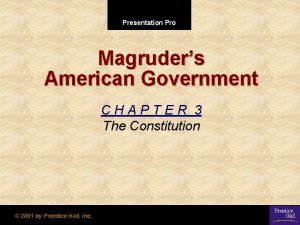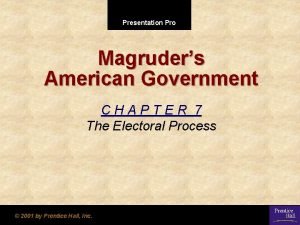Magruders American Government CHAPTER 3 The Constitution 2001






































- Slides: 38

Magruder’s American Government CHAPTER 3 The Constitution © 2001 by Prentice Hall, Inc.

CHAPTER 3 The Constitution SECTION 1 The Six Basic Principles SECTION 2 Formal Amendment SECTION 3 Informal Amendment 1 2 3 Chapter 3

SECTION 1 The Six Basic Principles �What are the important elements of the Constitution? �What are the six basic principles of the Constitution? 2 3 Chapter 3, Section 1

Original US Constitution

An Outline of the Constitution • The Constitution sets out the basic principles upon which government in the United States was built. • The Constitution is a fairly brief document; it doesn’t have excessive provisions (a clause in a document an agreement). • The Constitution is organized into eight sections: the Preamble and seven articles. The original document is followed by 27 amendments 2 3 Chapter 3, Section 1

Articles of the Constitution � Preamble—States the purpose of the Constitution � Article I—Legislative Branch � Article II—Executive Branch � Article III—Judicial Branch � Article IV—Relations among the States and with the National Government � Article V—Amending the Constitution � Article VI—National debts, supremacy of national law, and oaths of office � Article VII—Ratifying the Constitution

6 Basic Principles • The principle of popular sovereignty asserts that the people are the only source of any and all government power, and government can exist only with the consent of the governed. • The principle of limited government states that government is restricted in what it may do, and each individual has rights that government cannot take away. • Constitutionalism—government must be conducted based on Constitutional principals • Rule of Law—government and its officials are never above the law • Separation of powers is the principle in which the executive, legislative, and judicial branches of government are three independent and coequal branches of government. Chapter 3, Section 1 • 2 3

Basic Principles cont. • Checks and balances is the system that allows the legislative, executive, and judicial branches to check, or restrain, the actions of one another. • Veto—the President has the power to reject laws submitted by Congress, but Congress can override the veto with a 2/3 vote in both houses. • A presidential nominee to the Supreme Court must have Senate approval; the Supreme Court can declare a law unconstitutional. Unconstitutional is declaring a law illegal, null and void of all governmental action. Congress has the right to, and has, impeached a President—Andrew Johnson 1868 and Bill Clinton 1998—but they were acquitted by the Senate. • The principle of judicial review consists of the power of a court to determine the constitutionality of a governmental action.

2 3 Chapter 3, Section 1

Judicial Review The judicial branch set its power in the court case; Marbury vs. Madison, in this case: • Definition: First decision by the Supreme Court to declare a law unconstitutional (1803). • Summary: • At the very end (last night) of his term, President John Adams had made many federal appointments, including William Marbury as justice of the peace in the District of Columbia. • Thomas Jefferson, the new president, refused to recognize the appointment of Marbury. • The normal practice of making such appointments was to deliver a "commission, " or notice, of appointment. This was normally done by the Secretary of State. Jefferson's Secretary of State at the time was James Madison.

• At the direction of Jefferson, Madison refused to deliver Marbury's commission. Marbury sued Madison, and the Supreme Court took the case. • Chief Justice John Marshall wrote that the Judiciary Act of 1789, which spelled out the practice of delivering such commissions for judges and justices of the peace, was unconstitutional because it gave the Supreme Court authority that was denied it by Article III of the Constitution. So, the Supreme Court said, the Judiciary Act of 1789 was illegal and not to be followed. • This was the first time the Supreme Court struck down a law because it was unconstitutional. It was the beginning of the practice of "judicial review. " The Supreme Court has struck down several legislative and executive actions as well as state mandates.

� Federalism--A system of government in which the powers of government are divided between a central government and several local governments. Federalism is a key component of the Constitution's web of protections for individual freedom.

Federalism

Section 1 Review 1. Article II of the Constitution establishes the powers of the (a) executive branch. (b) legislative branch. (c) States. (d) judicial branch. 2. The principle of popular sovereignty asserts that the (a) government should be divided into three branches. (b) monarch is the supreme ruler. (c) means of production should be owned by the proletariat. (d) people are the source of any and all government power. 2 3 Chapter 3, Section 1

SECTION 2 Formal Amendment �What are the different ways to formally amend, or change the wording of, the Constitution? �How many times has the Constitution been amended? �What are the Bill of Rights? 1 3 Chapter 3, Section 2

A Living Document �US Constitution is the oldest national constitution in the world. �Today’s Constitution is not the same document that was written in 1787. �Things have been modified, deleted and added to the document

Amending the Constitution �The Constitution provides for its own amendment—that is, for changes in its written words. Article V (5) sets out two methods for proposal and two methods for the ratification of amendments. �Article V sets out two methods for the proposal and two methods for the ratification of constitutional amendments, creating four possible methods of formal amendment. � 1 3 Chapter 3, Section 2

Formal Amendment Process The four different ways by which amendments may be added to the Constitution are shown here:

Frist Method 1—Congress Proposes 2/3 vote both houses— ¾ State Legislature Ratifies

Second Method �Method 2—Congress Proposes 2/3 vote both house— ¾ State Convention Ratifies �Only the 21 st amendment was adopted this way.

Third Method �Method 3—National Convention (called by congress at the request of 2/3 of the State Legislatures) Proposes— 3/4 State Legislature Ratifies

Fourth Method 4—National Convention (called by congress at the request of 2/3 of the State Legislatures) Proposes— 3/4 State Convention Ratifies (basically how the Constitution was adopted) The amendment process focuses on the federal character of the governmental system.

Bill of Rights Amendments to the Constitution Collectively, the first ten amendments are known as the Bill of Rights. They set out many of our basic freedoms. The Bill of Rights: Amendment I Freedoms, Petitions, Assembly—Congress shall make no law respecting an establishment of religion, or prohibiting the free exercise thereof; or abridging the freedom of speech, or of the press, or the right of the people peaceably to assemble, and to petition the Government for a redress of grievances. Amendment II Right to bear arms—A well-regulated Militia, being necessary to the security of a free State, the right of the people to keep and bear Arms, shall not be infringed. Amendment III Quartering of soldiers—No Soldier shall, in time of peace be quartered in any house, without the consent of the Owner, nor in time of war, but in a manner to be prescribed by law.

Amendment IV Search and arrest—The right of the people to be secure in their persons, houses, papers, and effects, against unreasonable searches and seizures, shall not be violated, and no Warrants shall issue, but upon probable cause, supported by Oath or affirmation, and particularly describing the place to be searched, and the persons or things to be seized. Amendment V Rights in criminal cases—No person shall be held to answer for a capital, or otherwise infamous crime, unless on a presentment or indictment of a Grand Jury, except in cases arising in the land or naval forces, or in the Militia, when in actual service in time of War or public danger; nor shall any person be subject for the same offence to be twice put in jeopardy of life or limb, nor shall be compelled in any criminal case to be a witness against himself, nor be deprived of life, liberty, or property, without due process of law; nor shall private property be taken for public use, without just compensation. Amendment VI Right to a fair trial—In all criminal prosecutions, the accused shall enjoy the right to a speedy and public trial, by an impartial jury of the State and district wherein the crime shall have been committed; which district shall have been previously ascertained by law, and to be informed of the nature and cause of the accusation; to be confronted with the witnesses against him; to have compulsory process for obtaining witnesses in his favor, and to have the assistance of counsel for his defense.

Amendment VII Rights in civil cases—In Suits at common law, where the value in controversy shall exceed twenty dollars, the right of trial by jury shall be preserved, and no fact tried by a jury shall be otherwise re-examined in any Court of the United States, than according to the rules of the common law. Amendment VIII Bail, fines, punishment—Excessive bail shall not be required, nor excessive fines imposed, nor cruel and unusual punishments inflicted. Amendment IX Rights retained by the People—The enumeration in the Constitution of certain rights shall not be construed to deny or disparage others retained by the people. Amendment X States' rights—The powers not delegated to the United States by the Constitution, nor prohibited by it to the States, are reserved to the States respectively, or to the people.

Amendments to the Constitution There are several amendments that have been proposed but have not been ratified. 1 3 Chapter 3, Section 2

Amendments

Section 2 Review 1. A formal amendment (a) changes the Constitution by passing laws. (b) changes the written language of the Constitution itself. (c) allows States to secede from the United States. (d) none of the above. 2. Many of the basic rights of citizens are constitutionally guaranteed in (a) English common law. (b) the Declaration of Independence. (c) the Magna Carta. (d) the Bill of Rights. 1 3 Chapter 3, Section 2

SECTION 3 Informal Amendment �How has basic legislation changed the Constitution over time? �What powers do the executive branch and the courts have to amend the Constitution? �What role do party politics and custom have in shaping the Federal Government? 1 2 Chapter 3, Section 3

Informal Amendment Processes There are many interpretations to the Constitution that do not involve any changes to its written words. There are several ways to informally amend the Constitution. 1) 2) 3) 4) 5) Passage of basic legislation by Congress Actions taken by the President Key decisions by the Supreme Court Activities of political parties Custom and Usage 1 2 Chapter 3, Section 3

Basic Legislation Congress passes laws to clarify the Constitution’s provisions; it is described as adding flesh to the bones of the Constitution. Congress has added laws to help explain what some of the Constitution’s powers to Congress mean.

Executive Action � Presidential actions have produced a number of important informal amendments, such as the use of the military under the power of commander in chief. � An executive agreement is a pact made by the President directly with the head of a foreign state. � A treaty, a formal agreement between two or more sovereign nations, is only allowed with the approval of the Senate. � Executive power has been expanded over the years to include more and more power for the President

Court Decisions �The nation’s courts, most importantly the United States Supreme Court, interpret and apply the Constitution in many cases they hear.

Political Party Practices �Political parties are not mentioned in the Constitution and were described as having a divisive(dividing) effect on the country �Political Parties hold national conventions and they are not mentioned, they have over time converted the Electoral College

Custom& Usage Custom and Usage �A custom is something that has been done for years and others continue the practice. George Washington created the first cabinet, presidential advisory body. The original cabinet has expanded from 4 to 15.

Current Cabinet Secretary of State Secretary of the Treasury Secretary of Defense Attorney General John Kerry Jacob Lew Chuck Hagel Eric Holder (resigned 9/25/2014) Secretary of the Interior Secretary of Agriculture Secretary of Commerce Secretary of Labor Secretary of Health and Human Services Secretary of Housing and Urban Development Secretary of Transportation Secretary of Energy Secretary of Education Secretary of Veterans Affairs Secretary of Homeland Security Sally Jewell Tom J. Vilsack Penny Pritzker Thomas E. Perez Sylvia Mathews Burwell Julián Castro Anthony Foxx Ernest Moniz Arne Duncan Robert Mc. Donald Jeh Johnson

Custom & Usage � Senatorial Courtesy is a practice where senators will not confirm nominees to official positions without the approval of the senators from the home state of the nominee. This practice is not official or codified, but it is generally accepted in Senate practice and has been since 1789. � The no third term tradition started by George Washington was continued until Franklin D Roosevelt was elected for four terms. After this the 22 nd Amendment was passed to limit presidential terms to two-four year terms.

Videos
 Magruder's principle
Magruder's principle Texas constitution vs u.s. constitution venn diagram
Texas constitution vs u.s. constitution venn diagram Nc constitution vs us constitution
Nc constitution vs us constitution Constitution what is constitution
Constitution what is constitution Lesson 1 principles of the constitution
Lesson 1 principles of the constitution Six basic principles of the constitution
Six basic principles of the constitution The constitution lesson 2 the three branches of government
The constitution lesson 2 the three branches of government Chapter 2 american government
Chapter 2 american government Chapter 2 origins of american government vocabulary
Chapter 2 origins of american government vocabulary Chapter 2 origins of american government answer key
Chapter 2 origins of american government answer key Chapter 2 origins of american government worksheet answers
Chapter 2 origins of american government worksheet answers Chapter 2 lesson 1 origins of american government
Chapter 2 lesson 1 origins of american government Chapter 2 origins of american government
Chapter 2 origins of american government American government chapter 4
American government chapter 4 Preamble of usa
Preamble of usa American constitution
American constitution State and federal constitutions
State and federal constitutions Origins of american government section 4
Origins of american government section 4 Ap gov unit 1 study guide
Ap gov unit 1 study guide Unit 1 foundations of american government
Unit 1 foundations of american government Origins of american government section 1
Origins of american government section 1 Foundations of american government unit test
Foundations of american government unit test Origins of american government section 1
Origins of american government section 1 6 purposes of government
6 purposes of government Chapter 8 lesson 1 principles of the constitution answers
Chapter 8 lesson 1 principles of the constitution answers Ratifying the constitution chapter 5 section 3
Ratifying the constitution chapter 5 section 3 Chapter 5 section 2 drafting the constitution
Chapter 5 section 2 drafting the constitution Creating the constitution answer key chapter 2 section 4
Creating the constitution answer key chapter 2 section 4 Chapter 7 lesson 2 forging a new constitution
Chapter 7 lesson 2 forging a new constitution Chapter 2 lesson 4 creating the constitution
Chapter 2 lesson 4 creating the constitution Chapter 9 the constitution a more perfect union
Chapter 9 the constitution a more perfect union Ratifying the constitution chapter 5 section 3
Ratifying the constitution chapter 5 section 3 Chapter 3 section 1 constitution scavenger hunt answers
Chapter 3 section 1 constitution scavenger hunt answers Chapter 5 section 3 ratifying the constitution answer key
Chapter 5 section 3 ratifying the constitution answer key Chapter 9 the confederation and the constitution
Chapter 9 the confederation and the constitution Tci chapter 8 - creating the constitution answer key
Tci chapter 8 - creating the constitution answer key Chapter 9 confederation and constitution
Chapter 9 confederation and constitution Chapter 8 confederation to constitution
Chapter 8 confederation to constitution Chapter 8 creating the constitution
Chapter 8 creating the constitution







